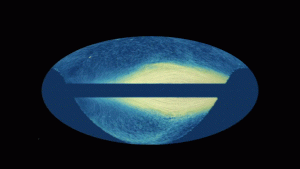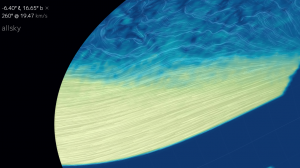
A GIF of two possible map locations – note that this image does not fully illustrate the map’s interactive potential. Click to play.
A Dunlap Postdoc has created a new way to visualize and interpret the stars in the Milky Way, centred around the Sun.
With the help of his colleagues, Banting & Dunlap Postdoctoral Fellow Dr. Josh Speagle used publicly available datasets and statistical methods to map out the distances to, and properties of, 170 million stars in the Milky Way.
“This is a totally new way to visualize and interpret the properties of hundreds of millions of stars,” Speagle explains.
The moving lines in the map trace the bulk motion of many stars. The background colours highlight properties such as speed, density, or chemical composition. As Speagle explains, you can change the viewpoint, projection, and various highlighted properties by clicking/dragging around on the interface. You can gather information such as speed and direction by clicking a particular point.
With this tool, Speagle says his team hopes to learn more about the past history and present-day structure of our Galaxy.
So what happens next? “We’re currently working on scaling up to all of the data, which includes over a billion stars and improving the data visualization interface to facilitate more detailed exploration. That will give us the first all-sky map that anyone can explore.”
Speagle says that these maps will help to identify new structure and dynamics, such as merging galaxies or spiral arms.
“These maps will help us piece together how our Milky Way Galaxy looks, how it came to be where it is today, and how it’s evolving over time.”
__________________________________________________________________________________________
Access the interactive map here: http://allsky.s3-website.us-east-2.amazonaws.com.
Map credit: Josh Speagle; Catherine Zucker, Center for Astrophysics, Harvard & Smithsonian and STScI; Ana Bonaca, Center for Astrophysics, Harvard & Smithsonian. The map is based on open-source code from Cameron Beccario.
For more information, please contact:
Meaghan MacSween
Communications and Multimedia Officer
Dunlap Institute for Astronomy & Astrophysics,
University of Toronto
meaghan.macsween@utoronto.ca
The Dunlap Institute for Astronomy & Astrophysics at the University of Toronto is an endowed research institute with more than 90 faculty, postdocs, students and staff, dedicated to innovative technology, ground-breaking research, world-class training, and public engagement. The research themes of its faculty and Dunlap Fellows span the Universe and include: optical, infrared and radio instrumentation; Dark Energy; large-scale structure; the Cosmic Microwave Background; the interstellar medium; galaxy evolution; cosmic magnetism; and time-domain science. The Dunlap Institute for Astronomy and Astrophysics, David A. Department of Astronomy & Astrophysics and the Canadian Institute for Theoretical Astrophysics comprise the leading centre for astronomical research in Canada, at the leading research university in the country, the University of Toronto.


